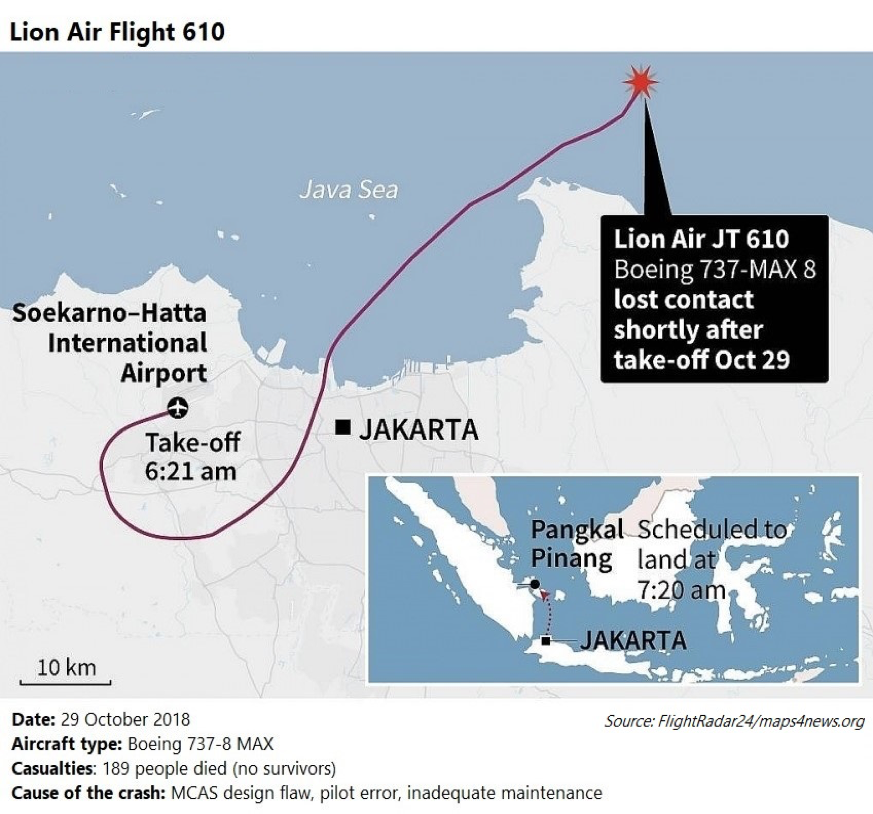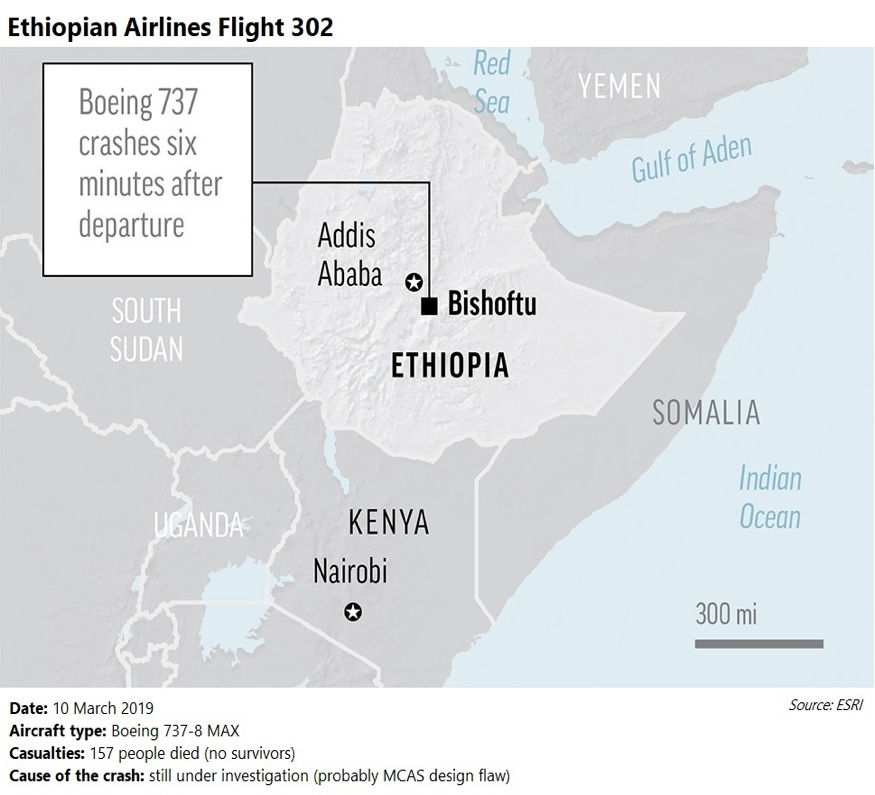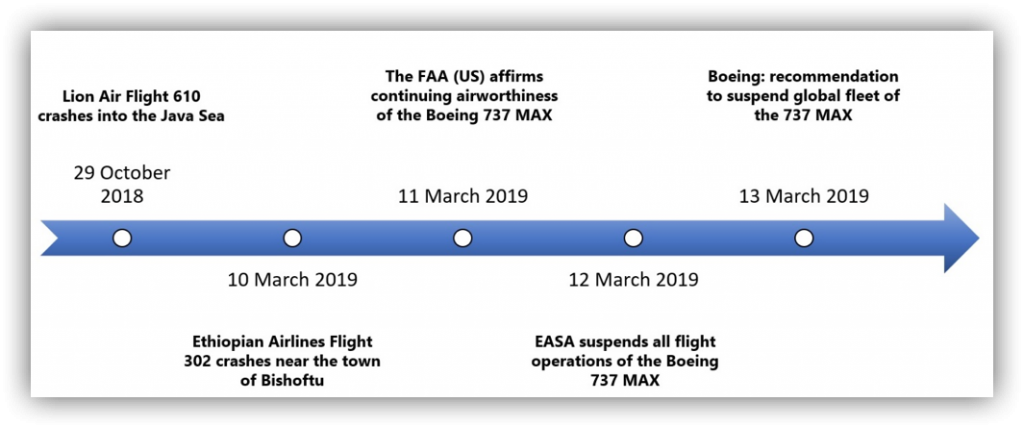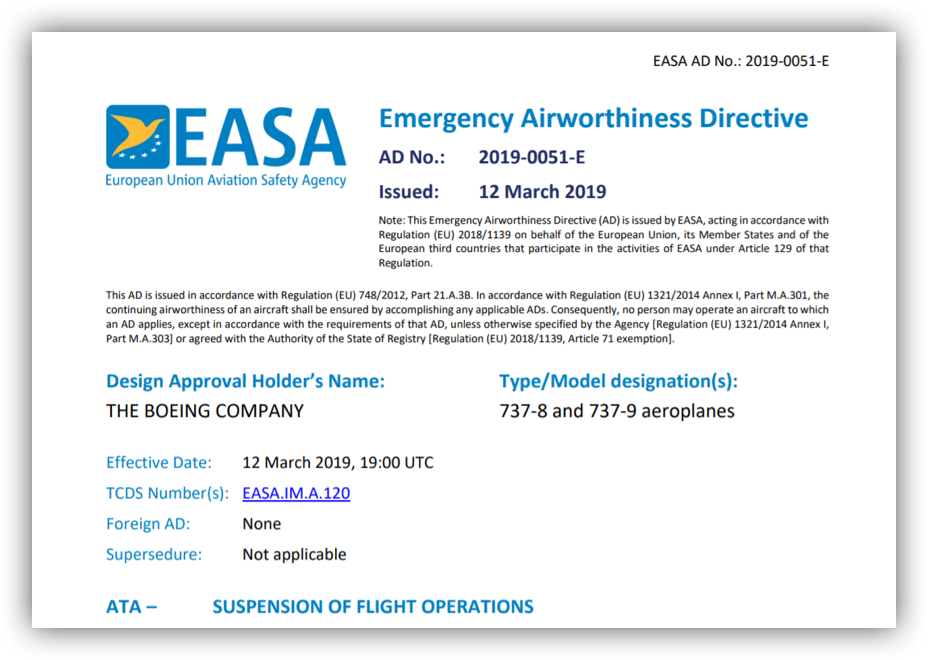By Daniel, Sander & Paul
The Boeing 737 MAX crisis
On 29 October 2018, flight 610 from Lion Air took off from Jakarta, on its way to Pangkal Pinang in Indonesia. The 189 passengers and crew prepared for a short flight across the Java Sea, which came to an abrupt end when the airplane hit the surface of the Sea after just 13 minutes. A similar event took place only 4 months later. Flight 302 from Ethiopian Airlines had taken off from Addis Ababa and was on its way to Nairobi. After just one minute, a chain of irrevocable events began which eventually led to the airplane crashing near the town of Bishoftu.


After suspicion arose that the cause of both accidents could be traced back to the same design flaw of the Boeing 737-8 MAX (hereinafter: “MAX”), concerns as to the safety of other MAX airplanes spread among aviation experts. However, the Federal Aviation Authority (FAA) of the United States, Boeing’s home soil, released a notification which affirmed the continuing airworthiness of the MAX and stated that it was too early “to draw any conclusions”. Meanwhile in the EU, several Member States grounded the MAX in anticipation of the decision of the European Aviation Safety Agency (EASA), which is responsible for pan-European aviation safety. Only a few hours later, EASA suspended all flight operations of the MAX within the European airspace. Many countries followed a day later, including the US which, after President Trump’s intervention, altered its initial reluctance to act. To eliminate any final doubts, Boeing itself issued a recommendation to suspend the entire global fleet of the MAX.
This blog post will discuss EASA’s role in the event of an aviation safety crisis. It is argued that the Boeing crisis demonstrates the importance of EASA in ensuring uniformity of the European airspace and its importance as a global actor in protecting international aviation safety.

How EASA dealt with the crisis
EASA has several powers in the enforcement of EU aviation policy (based on Regulation 2018/1139). One of their responsibilities is ensuring the continuing airworthiness of aircrafts (Regulation 1321/2014). To ground specific airplane types, EASA can issue so-called Airworthiness Directives (ADs). To issue an AD, the following steps have to be taken (Regulation (EU) 748/2012, part 21.A.3B).
First of all, the agency identified the unsafe situation. EASA could not investigate the airplane crashes themselves, but the finding of the unsafe condition, in this case a similar design flaw that resulted in the two accidents, was based on the information provided for by other aviation authorities (e.g. the FAA). Secondly, the concerned aircraft type was identified. Both accidents involved the Boeing 737-8 MAX airplane and both were caused by a similar design flaw in the so-called MCAS system, which stabilizes the airplane while flying. While both the MAX 8 and 9 types apply the MCAS system, both types were grounded. Finally, appropriate action had to be taken to prevent any further incidents. Accordingly, EASA decided to suspend operations of the MAX airplane, except for a single flight to return to home base.
In the context of the Boeing crisis, EASA decided to issue several ADs. First, a so-called Emergency Airworthiness Directive was adopted, thereby suspending all flight operations of the MAX within the EU. EASA’s influence is, however, not limited to European operators only. On the very same day, the agency issued a Safety Directive applicable to the same airplane type but operated by third country operators flying into or out of the EU. Two weeks later, EASA issued yet another AD for non-passenger flights of the affected aircraft type (so-called ferry flights), thereby getting close to a total ban on the operation of the MAX.

EASA’s importance as a global actor
The foregoing has demonstrated how EASA operates in the event of an aviation safety crisis. The next question that arises is what exactly is the added value or importance of a European agency in the network of international coordination on aviation safety.
First of all, EASA ensures the uniformity of the European Union airspace. EASA’s ADs to suspend all flight operations of the MAX were meant to harmonise diverging decisions by the Member States on the suspension of the MAX. For example, the Netherlands and UK had already grounded the MAX hours before. Both Member States revoked their decision after EASA’s pan-European judgement was released. A single and uniform decision of the EU has strong international implications. EASA’s counterparts around the world are much more likely to follow a course of action that extends to all EU member states.
Secondly, EASA is increasingly presenting itself as a strong player on the international level. EASA historically had trusted the FAA’s certifications and standards in an acknowledgement of their expertise. However, this trust had been shaken as a result of the Boeing crisis, and EASA had to step up to the plate to ensure the safety of aviation within the European airspace. What are the reasons for this rare lack of trust? Following the two MAX crashes, questions started being asked regarding Boeing’s MCAS system. While several other major jurisdictions already grounded the MAX, the FAA stood their ground in defending the airworthiness of the MAX. Furthermore, this decision was even more questionable due to the FAA’s ‘self-approval’ approach with Boeing, which leaves a large portion of the evaluation and greenlighting of the MCAS system up to Boeing itself. Based on the foregoing, and the fact that there was insufficient knowledge and awareness of the MCAS system among aviation authorities, EASA stepped up to the FAA and insisted on doing their own inspections of the MAX.
The Boeing crisis demonstrates the increased scrutiny of the MAX airplanes by EASA. The agency not only ensures a common approach within the European airspace but also stepped up to their international counterparts such as the FAA. Several grounds for not trusting the FAA’s judgement made EASA insist to do their own inspections in regard to the issuing of a certificate to the MAX after the improvements made by Boeing to the MCAS system. To demonstrate EASA’s determination in taking this crisis seriously, the agency is currently still investigating the MAX airplane and its flight suspension is still in force.
